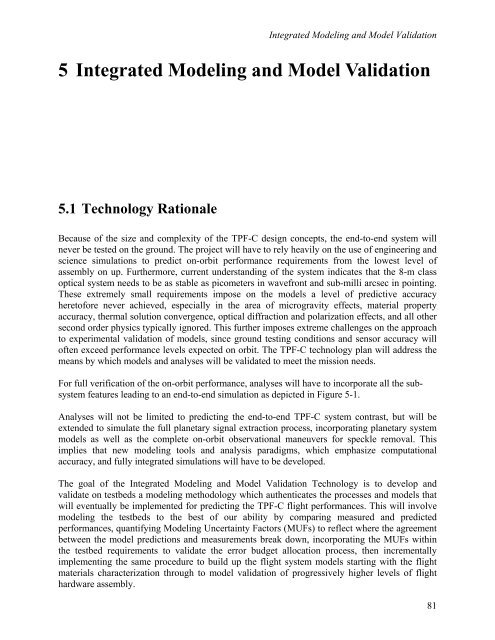TPF-C Technology Plan - Exoplanet Exploration Program - NASA
TPF-C Technology Plan - Exoplanet Exploration Program - NASA
TPF-C Technology Plan - Exoplanet Exploration Program - NASA
You also want an ePaper? Increase the reach of your titles
YUMPU automatically turns print PDFs into web optimized ePapers that Google loves.
Integrated Modeling and Model Validation<br />
5 Integrated Modeling and Model Validation<br />
5.1 <strong>Technology</strong> Rationale<br />
Because of the size and complexity of the <strong>TPF</strong>-C design concepts, the end-to-end system will<br />
never be tested on the ground. The project will have to rely heavily on the use of engineering and<br />
science simulations to predict on-orbit performance requirements from the lowest level of<br />
assembly on up. Furthermore, current understanding of the system indicates that the 8-m class<br />
optical system needs to be as stable as picometers in wavefront and sub-milli arcsec in pointing.<br />
These extremely small requirements impose on the models a level of predictive accuracy<br />
heretofore never achieved, especially in the area of microgravity effects, material property<br />
accuracy, thermal solution convergence, optical diffraction and polarization effects, and all other<br />
second order physics typically ignored. This further imposes extreme challenges on the approach<br />
to experimental validation of models, since ground testing conditions and sensor accuracy will<br />
often exceed performance levels expected on orbit. The <strong>TPF</strong>-C technology plan will address the<br />
means by which models and analyses will be validated to meet the mission needs.<br />
For full verification of the on-orbit performance, analyses will have to incorporate all the subsystem<br />
features leading to an end-to-end simulation as depicted in Figure 5-1.<br />
Analyses will not be limited to predicting the end-to-end <strong>TPF</strong>-C system contrast, but will be<br />
extended to simulate the full planetary signal extraction process, incorporating planetary system<br />
models as well as the complete on-orbit observational maneuvers for speckle removal. This<br />
implies that new modeling tools and analysis paradigms, which emphasize computational<br />
accuracy, and fully integrated simulations will have to be developed.<br />
The goal of the Integrated Modeling and Model Validation <strong>Technology</strong> is to develop and<br />
validate on testbeds a modeling methodology which authenticates the processes and models that<br />
will eventually be implemented for predicting the <strong>TPF</strong>-C flight performances. This will involve<br />
modeling the testbeds to the best of our ability by comparing measured and predicted<br />
performances, quantifying Modeling Uncertainty Factors (MUFs) to reflect where the agreement<br />
between the model predictions and measurements break down, incorporating the MUFs within<br />
the testbed requirements to validate the error budget allocation process, then incrementally<br />
implementing the same procedure to build up the flight system models starting with the flight<br />
materials characterization through to model validation of progressively higher levels of flight<br />
hardware assembly.<br />
81
















